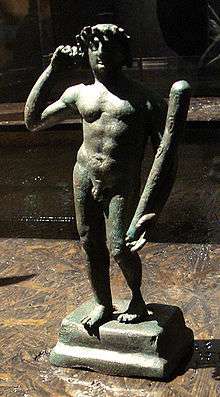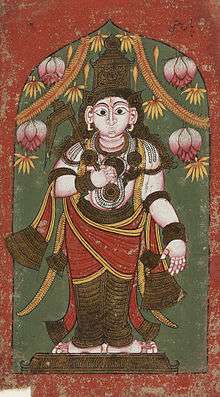Megasthenes' Herakles
Megasthenes' Herakles is the conventional name of reference of an ancient Indian deity. Herakles was originally a classical Greek divinity. However, in the aftermath of Alexander the Great's conflicts in North-Western India, an Indian version of this classical Greek deity was identified by Megasthenes, who travelled to India as the ambassador of the Seleucids during the reign of Chandragupta Maurya. Upon visiting Mathurai of the Early Pandyan Kingdom, he described the kingdom as being named after Pandaea, Herakles' only daughter.


Statement by Megasthenes
Megathenes in Indica reports on the Indian deity as similar to Herakles:
Such, then are the traditions regarding Dionysus and his descendants current among the Indians who inhabit the hill-country. They further assert that Herakles also was born among them. They assign to him like Greeks, the clubs and the lion's skin. He far surpassed other men in personal strength and prowess, and cleared sea and land of evil beasts. Marrying many wives he begot many sons, but one daughter only. The sons having reached man's estate, he divided all India into equal portions for his children, whom he made kings in different parts of his dominion. He provided similarly for his daughter, whom he reared up and made a queen. He was the founder, also, of no small number of cities, the most renowned and greatest of which he called Palibothra (Pataliputra). He built therein many sumptuous palaces, and settled within its walls a numerous population. The city he fortified with trenches of notable dimensions, which were filled with water introduced from the river. Herakles, accordingly, after his removal from among the men, obtained immortal honor; and his descendants, having reigned for many generations and signalized themselves by great achievements, neither made any expedition beyond the confines of India, nor sent out any colony abroad. At last however, after many years had gone, most of the cities adopted the democratic form of government, though some retained the kingly until the invasion of the country by Alexander.
— Ancient India as described by Megasthenes and Arrian - Dr. Schwanbeck and J.W. McCrindle (1877), pp. 57–58 [5]
Megasthenes' Herakles as Vāsudeva-Krishna
Many scholars have suggested that the deity should be identified as Vāsudeva-Krishna.[6][2] Edwin Francis Bryant comments the following in this regard:
According to Arrian, Diodorus, and Strabo, Megasthenes described an Indian tribe called Sourasenoi, who especially worshipped Herakles in their land, and this land had two cities, Methora and Kleisobora, and a navigable river, the Jobares. As was common in the ancient period, the Greeks sometimes described foreign gods in terms of their own divinities, and there is a little doubt that the Sourasenoi refers to the Shurasenas, a branch of the Yadu dynasty to which Krishna belonged; Herakles to Krishna, or Hari-Krishna: Mehtora to Mathura, where Krishna was born; Kleisobora to Krishnapura, meaning "the city of Krishna"; and the Jobares to the Yamuna, the famous river in the Krishna story. Quintus Curtius also mentions that when Alexander the Great confronted Porus, Porus's soldiers were carrying an image of Herakles in their vanguard.
— Krishna: a sourcebook, Edwin Francis Bryant, Oxford University Press US, 2007[7]
Megasthenes' Herakles as Baladeva
James Tod associated Herakles primarily with Baladeva, Krishna's older sibling, but also indicated that Herakles could be associated with both:
How invaluable such remnants of ancient race of Harikula! How refreshing to the mind yet to discover, amidst the ruins on the Yamuna, Hercules (Baldeva, god of strength) retaining his club and lion's hide, standing on his pedestal at Baldeo, and yet worshipped by Suraseni! This was name given to a large tract of country round Mathura, or rather round Surpura, the ancient capital founded by Surasena, the grandfather of the Indian brother-deities, Krishna and Baldeva, Apollo and Hercules. The title would apply to either ; though Baldeva has the attributes of 'god of strength'. Both are es (lords) of the race (kula) of Hari (Hari-kul-es), of which the Greeks might have made the compound Hercules.
— James Tod, Annals and Antiquities of Rajasthan [8]
Megasthenes' Herakles as Shiva
According to Quintus Curtius, the Sibae, whom he calls Sobii, occupied the country between the Hydaspes and the Akesines. They may have derived their name from the god Siva.[9]
Again when Alexander had captured at the first assault the rock called Aornos, the base of which is washed by the Indus near its source, his followers, magnifying the affairs, affirmed that Herakles had thrice assaulted the same rock and had been thrice repulsed. They said also that the Sibae were descended from those who accompanied Herakles on his expedition, and that they preserved badges of their descent, for they wore skins like Herakles and carried clubs, and branded the mark of a cudgel on their oxen and mules.
— Ancient India as described by Megasthenes and Arrian - Dr. Schwanbeck and J.W. McCrindle (1877), pp. 128–129 [10]
According to Dr. Schwanbeck and J. W. McCrindle, Megasthenes meant Siva when he mentioned Herakles in his book Indika[11]
See also
References
- "A much better known «syncretistic» image is the one depicted on a well-known «nicolo» seal (....) Ghirshman thought of a composite deity (Mihira-Visnu-Siva, Ibidem: 55-58), although an identification with the god Vasudeva is perhaps more likely (Mitterwallner 1986: 10)" "Silk Road Art and Archaeology: Journal of the Institute of Silk Road Studies, Kamakura". The Institute. 1996: 170. Cite journal requires
|journal=(help) - Singh, Upinder (2008). A History of Ancient and Early Medieval India: From the Stone Age to the 12th Century. Pearson Education India. p. 436-438. ISBN 978-81-317-1120-0.
- Osmund Bopearachchi, Emergence of Viṣṇu and Śiva Images in India: Numismatic and Sculptural Evidence, 2016.
- Srinivasan, Doris (1997). Many Heads, Arms, and Eyes: Origin, Meaning, and Form of Multiplicity in Indian Art. BRILL. p. 215. ISBN 978-90-04-10758-8.
- Ancient India as described by Megasthenes and Arrian, By Dr. Schwanbeck and J.W. McCrindle (1877), pp. 57–58
- Bryant, Edwin Francis (2007). Krishna: A Sourcebook. Oxford University Press. p. 5-6. ISBN 978-0-19-803400-1.
- Krishna: a sourcebook, p. 5, Edwin Francis Bryant, Oxford University Press US, 2007
- Annals and Antiquities of Rajast'han, Or, The Central and Western Rajpoot States of India, James Tod, pp 36, Published by Higginbotham and co., 1873, Item notes: v. 1, Original from Oxford University
- Ancient India as described by Megasthenes and Arrian, By Dr. Schwanbeck and J.W. McCrindle (1877), p. 129
- Ancient India as described by Megasthenes and Arrian, By Dr. Schwanbeck and J.W. McCrindle (1877), pp. 128–129
- Apparently Siva is meant, though his many wives and sons are unknown to Hindu mythology. Ancient India as described by Megasthenes and Arrian, By Dr. Schwanbeck and J.W. McCrindle (1877), p. 57
